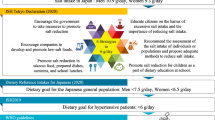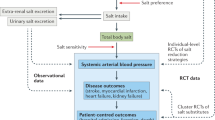Abstract
Objective: To assess current habits of using salt and other seasonings in food preparation, and to investigate the psychosocial determinants of salt use. In addition we examined differences in salt consumption and psychosocial determinants with respect to stages of change and socio-economic classes.
Subjects and methods: 400 adults were interviewed to determine: 1) use of salt and other seasonings in food preparation; 2) added table salt; 3) consumption of foods with high salt content; and 4) psychosocial determinants of salt consumption. Subjects were divided into 5 stages of change for salt content of the cooked meal: precontemplation, contemplation, decision, action and maintenance.
Results: Salt appeared to be the type of seasoning mostly added in food preparation. Frequently used seasonings containing no added salt were pepper, onion, nutmeg, garlic, curry, sweet pepper powder, parsley, and bay-leaf.
Spearman correlation coefficients between added cooking salt and taste attitude, health attitude, social influence and self-efficacy were 0.51, 0.14, 0.36, and 0.32 respectively. Correlations between consumption of foods with high salt content and convenience attitude, taste attitude, health attitude and self-efficacy were 0.41, 0.27, 0.18 and 0.21 respectively. Subjects in maintenance of low salt consumption, used less salt than subjects in precontemplation. Socio-economic status only showed an effect on the use of foods with high salt content.
Conclusion and practical implications: Health aspects did not play a major role in salt intake, whereas taste attitude was an important predictor of added cooking salt. Attempts to reduce cooking salt should be directed at satisfying taste. Nutrition education tailored to stages of change may be very helpful in decreasing salt consumption.
Sponsorship: This study was supported by the Netherlands Heart Foundation under grant no. 604.350.3.
This is a preview of subscription content, access via your institution
Access options
Subscribe to this journal
Receive 12 print issues and online access
$259.00 per year
only $21.58 per issue
Buy this article
- Purchase on Springer Link
- Instant access to full article PDF
Prices may be subject to local taxes which are calculated during checkout
Similar content being viewed by others
Author information
Authors and Affiliations
Contributions
Contributorship: JV contributed to the design of the study, manual of operation, supervised the fieldwork, analysed data and did a great part on writing of the manuscript. CG was responsible for the part of the questionnaire examining psychosocial determinants about salt in foods, contributed to analyses of data and writing the manuscript. SD formulated the research question and contributed towards the design of the study, the manual of operation and the writing of the manuscript. WS formulated the research question and contributed towards the design of the study, the items in the questionnaire on food habits, data treatment and the writing of the manuscript. JV and WS are the guarantors for the study.
Rights and permissions
About this article
Cite this article
Van der Veen, J., De Graaf, C., Van Dis, S. et al. Determinants of salt use in cooked meals in the Netherlands: attitudes and practices of food preparers. Eur J Clin Nutr 53, 388–394 (1999). https://doi.org/10.1038/sj.ejcn.1600737
Received:
Revised:
Accepted:
Published:
Issue Date:
DOI: https://doi.org/10.1038/sj.ejcn.1600737
Keywords
This article is cited by
-
Adding salt to foods and hazards of microvascular, cerebrovascular and cardiovascular diseases
European Journal of Clinical Nutrition (2024)
-
Effect of monitoring salt concentration of home-prepared dishes and using low-sodium seasonings on sodium intake reduction
European Journal of Clinical Nutrition (2018)
-
Preference of food saltiness and willingness to consume low-sodium content food in a Chinese population
The Journal of nutrition, health and aging (2017)



